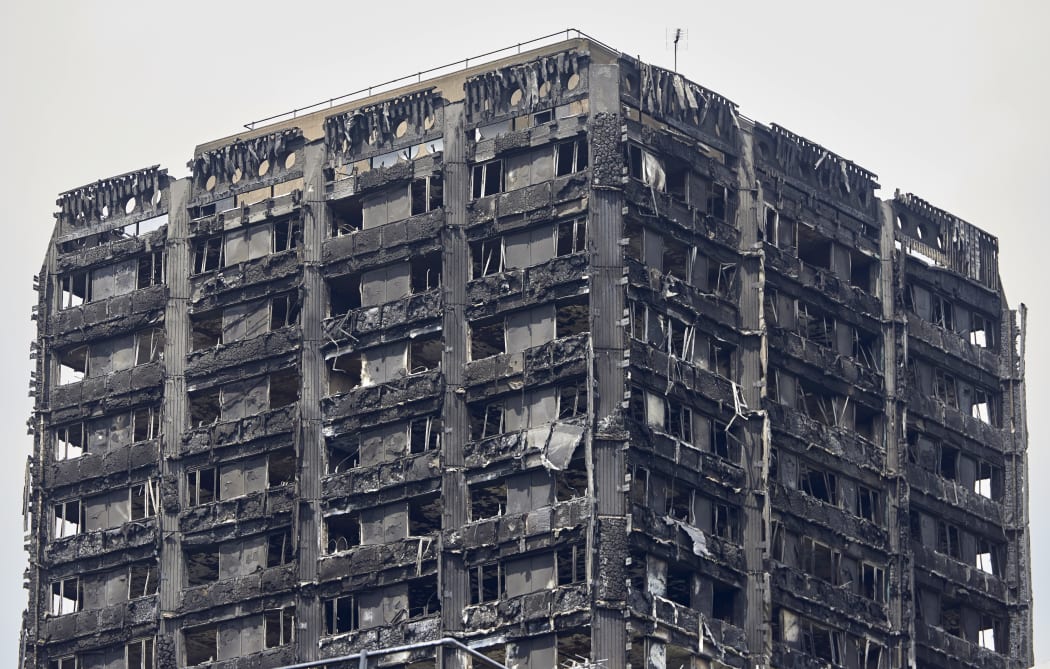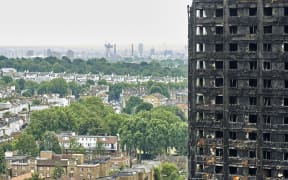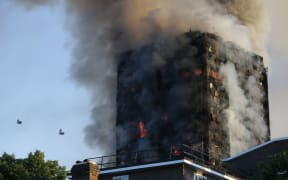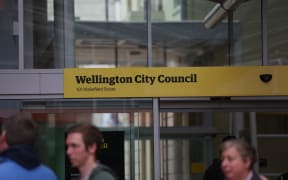Growing uncertainty around the fire safety rules for cladding on high-rise buildings is beginning to bite on the construction sector.

The charred remains of clading are pictured on the outer walls of the burnt out shell of the Grenfell Tower block in north Kensington, west London on June 22, 2017. Photo: AFP
Auckland Council has signalled delays in dealing with consents for types of aluminium composite panel cladding related to what was on Grenfell Tower, the London tower block where a fire killed 72 people.
But a leading panel supplier has warned against banning the product entirely.
Ian McCormick, general manager of building consents at Auckland Council, said building officers at the council were now "undertaking additional scrutiny of the entire cladding system."
"Consent applicants may experience longer associated processing times, due to the level of uncertainty that exist surrounding fire compliance of cladding systems and how applicants adequately demonstrate compliance."
The sole certifying company of panel in New Zealand, CertMark International or CMI, said developments were suffering.
"CMI has been informed that there are a number of major projects on hold in New Zealand as councils are refusing to approve buildings that have ACP cladding," it told RNZ by email.
"CMI is also informed that the building consent authorities are not going to approve these buildings until MBIE provide a direction."
The Society of Fire Protection Engineers said it understood the Ministry of Business, Innovation and Employment (MBIE) and Auckland Council were working on this.
But the weeding out of bad practices was beyond the powers of local councils, said Jan Gouws, whose Auckland company Kaneba has been a big supplier of the aluminium panel, sometimes called ACP, for more than a decade.
"This is not a scary product but it is too easy to cheat," Mr Gouws said.
His company had been advising caution for years but been widely ignored.
"We were raising awareness that what you install on a building could be potentially a fire risk, that you need to make sure that they actually are up to scratch," Mr Gouws said.
"No one wanted to know anything about it.
"They were not very much concerned about the quality of the product or the reputation about it, as long as someone installing it would say to them, 'listen, this is good enough'."
But Mr Gouws said the installation phase was where a common cheat occurred; he had firsthand knowledge of cheaper but highly flammable polyethylene-core, or PE, panel being used in place of what was actually consented, slightly pricier semi-combustible FR or fire-resistant panel.
Auckland Council confirmed its more cautious approach extended to the consenting of FR panels, even where they have a CodeMark certificate, which usually means their use cannot be challenged.
But the council did mount such a challenge last year. This resulted in an MBIE ruling, or determination, last December in which a fire scientist said not enough attention was being paid to whether the panel was being put on top of a combustible material, like wooden frames or non-fire-rated plasterboard.
The council's own year-long investigation earlier this month, after the Grenfell fire, revealed that it has no idea whether PE or FR panel had been used on 45 percent of the high-rises it consented; 53 out of 116 buildings were in this "unknown" category.
Wellington and Christchurch city councils have the same problem with "unknowns". However, both said they were not currently delaying designs that used the panel, and Wellington said it had not had many such designs through anyway.
But some fire engineers are making expensive design changes to do with the panels, or what is used underneath them.
"People are being more thorough in checking all the documentation and testing just to make sure it is suitable for its application," Michael James, president of the Society of Fire Protection Engineers said.
"Even as far as fire engineers go, they're putting everything under a lot more scrutiny."
The biggest design questions were around medium-risk buildings, which included many high-rises, he said.
Industry players said it appeared Auckland Council did not want to be the one blamed for holding projects up.
However, the time it is taking the regulator, MBIE, to regulate has sparked criticism, including from the opposition in Parliament last week, aimed against the building minister.
"It is causing a level of frustration, understandably, 'cos it is taking longer and people are having to be more rigorous and thorough in what they do," Michael James said.
Panel supplier Jan Gouws cautioned the ministry against going too far and banning the FR panel.
"It's a beautiful product... It's so unfortunate that the misuse of it has brought it into the state that it is at the moment because the country would be a loser if the product was banned."
Any alternative would be much more expensive.
"If we can just use it responsibly, by competent people, that would be the way to go," Mr Gouws said.
The uncertainty around the panel extends to the Codemark system itself.
Several leading fire engineers say the system, which MBIE owns, has allowed through certificates that fail to demonstrate the aluminium composite panels are safe.
Now, one of New Zealand's major Codemark certifiers, AsureQuality, is looking at pulling out of the scheme.
"As part a wider business review of our strategic priorities, we are currently reviewing our existing Codemark certification business," Aaron Lambert of AsureQuality said.
The pressure on Codemark puts pressure on CertMark, since the Queensland company is this country's largest overall Codemark certifier.
CertMark is now questioning why it took seven months for the ministry to get a second opinion about an audit last November that faulted CertMark's aluminium panel certificates.
John Thorpe, head of CertMark, said the process was much faster in Australia.
The audit and the second opinion were now with panel suppliers to give input, he said.
His company had already given the ministry the figures for how much combustible material was in the core of each type of FR panel certified; Mr Thorpe said this was as low as 9 percent, while none had more than 30 percent, above which flammability became a bigger issue.
However, he also admitted that none of the FR panel certified would pass the fire testing newly introduced in Australia, called AS5113.
"They will fail the flaming particle and particle size requirements of this test regime," he said by email to RNZ.
"This in itself doesn't mean the building is in danger, but it does mean that there need to be provisions made in regard to things like fire exits and the safety of first responders in a fire event."
Codemark certificates could not be site specific, so site-specific fire engineering would be needed, Mr Thorpe said.
Yet a major reason people use Codemark in the first place is so their project can get the green light without having to get expensive, site-specific engineering done.
New Zealand does not even use the AS5113 test, its standards instead relying on a 20-year-old version of a US test called NFPA285.
Yet this country has no facility that can run the US test, and getting any New Zealand-specific wall system design tested this way would cost tens of thousands of dollars. The result is that the US test is being used to approve New Zealand wall designs that are not like those used and tested in the US.





